The Prime Minister of Palestine, Mohammed Shtayyeh, announced the resignation of his government on Monday, potentially paving the way for reforms supported by the United States within the Palestinian Authority.
President Mahmoud Abbas will need to decide whether to accept the resignation. Nonetheless, this move indicates a readiness from the Western-backed Palestinian leadership to embrace changes that could rejuvenate the Palestinian Authority.
The US is pushing for a reformed Palestinian Authority to govern Gaza after the conflict. However, many challenges lie ahead in making this a reality.
Shtayyeh stated during a Cabinet meeting that new governmental and political arrangements are needed to address the evolving situation in the Gaza Strip.
It is expected that Mohammad Mustafa, the chairman of the Palestine Investment Fund, will be chosen as the next prime minister by Abbas.
The resignation of the Palestinian government comes after Israeli Prime Minister Benjamin Netanyahu claimed that a decisive victory in the Gaza territory of Rafah would occur within weeks, even if a ceasefire is reached.
Talks have resumed in Qatar and Egypt to achieve a ceasefire and secure the release of hostages held in Gaza and Palestinians imprisoned by Israel. To date, only 3 hostages have been saved via the ground offensive while over 100 hostages were freed during a ceasefire.
An Egyptian official, speaking anonymously, mentioned a proposed ceasefire deal involving the release of hostages and prisoners and the continuation of negotiations for a permanent ceasefire.
Negotiators face an unofficial deadline at the beginning of Ramadan, a period often marked by increased tensions.
Hamas claims it was not involved in the latest proposal, but the reported outline aligns with its earlier truce proposal.
Hamas demands the end of the offensive and the withdrawal of Israeli forces from the territory before releasing hostages. Israel rejects these conditions.
Israel is considering expanding its offensive to Rafah, where many have sought refuge, raising concerns about a humanitarian catastrophe.
Netanyahu plans to approve operational plans for Rafah, including evacuating civilians, through the Cabinet. However, many have asked where else the displaced civilians could go. The Egyptian government has made it clear that if any Palestinians are pushed into the Sinai desert, their peace treaty with Israel is at risk.
UN agencies and aid groups are struggling to deliver aid amid the hostilities and breakdown of order in Gaza.
Heavy fighting continues in northern Gaza, causing significant destruction and civilian suffering. This is despite the IDF’s claims that they had taken control of the north and that Hamas had been pushed further south. However, due to the intense, ongoing clashes in northern Gaza, that claim seems unlikely.
Israel maintains its military operations against Hamas while facing ongoing clashes with Hezbollah in the north. Reports indicate that there are just 3 IDF companies within Gaza, as most have been pulled out
The situation remains dire, with civilians bearing the brunt of the conflict’s impact. The IDF claims to have eliminated more than 10,000 Hamas militants, however, no evidence has been provided to substantiate these claims.



